快乐英语报范文
- 格式:doc
- 大小:18.02 KB
- 文档页数:7
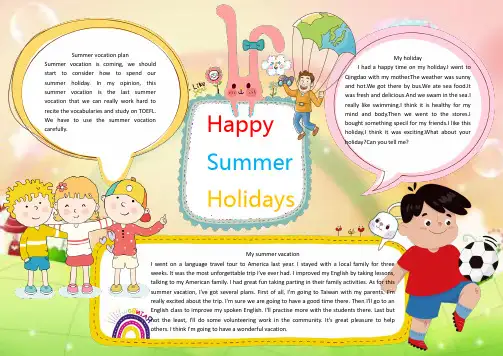
HappySummer Holidays My holiday I had a happy time on my holiday.I went to Qingdao with my mother.The weather was sunny and hot.We got there by bus.We ate sea food.It was fresh and delicious.And we swam in the sea.I really like swimming.I think it is healthy for my mind and body.Then we went to the stores.I bought something specil for my friends.I like this holiday,I think it was exciting.What about your holiday?Can you tell me?My summer vacationI went on a language travel tour to America last year. I stayed with a local family for three weeks. It was the most unforgettable trip I’ve ever had. I improved my English by taking lessons, talking to my American family. I had great fun taking parting in their family activities. As for this summer vacation, I've got several plans. First of all, I'm going to Taiwan with my parents. I'm really excited about the trip. I'm sure we are going to have a good time there. Then I'll go to an English class to improve my spoken English. I'll practise more with the students there. Last but not the least, I'll do some volunteering work in the community. It's great pleasure to help others. I think I'm going to have a wonderful vacation. Summer vocation planSummer vocation is coming, we shouldstart to consider how to spend oursummer holiday. In my opinion, thissummer vocation is the last summervocation that we can really work hard torecite the vocabularies and study on TOEFL.We have to use the summer vocationcarefully.。

Henan eat sugar stoves, burning, People in Guangdong eat and laba porridge. Cantonese dishes, orange, and green olives. Shanxi toeat dumplings, boiled pumpkin.班级:姓名:请把这串文字改成班级姓名The Chinese people for the New Year has 4000 years of history, which is emerging from the Yushun. One day more than 2,000 years BC, that the emperor Shun-bit, and led his men staff, to worship heaven and earth. From then on, people are put on this day as a Suishou can be regarded as the first month started this. This is said the origin of the Lunar New Year, and later called the Lunar New YearIn China, people in different places to eat different foods in the Chinese New Year. People in Zhejiang eat cake, longevity noodles and Trifle. People in Hunan betel nuts, the cock, and hot pot. People in Hubei eat chicken feet, fried egg and white Artemisia. People in The Spring Festival is the most important festival in China.People usually decorate the doors and windows with red papercuts.becousered means good luck.People usually clean house too.becouse they wantto sweepaway bad luck.Childrencanget some newclothesor presentsfrom their parents and grandparents.On New Year's Eve, family always have a big dinner.Everybody are watch TV and talk.In the midnight, there usually fairworks.On New Year's Day, people usually put on their new clothes and visit their femily and friends.They usually say:" Happy New Year's Day."。
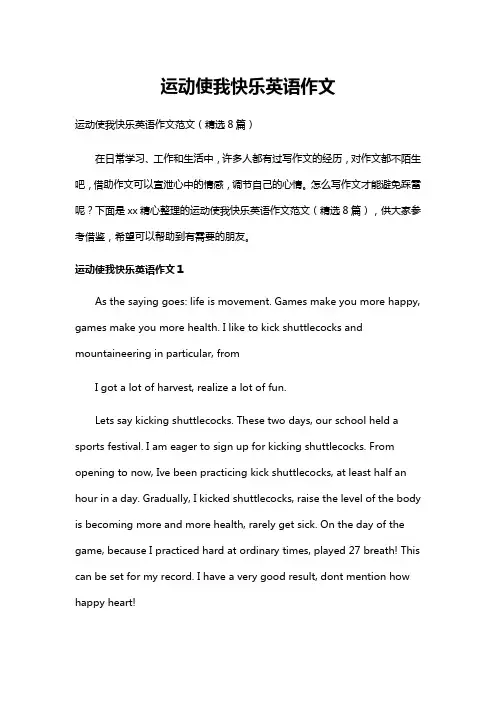
运动使我快乐英语作文运动使我快乐英语作文范文(精选8篇)在日常学习、工作和生活中,许多人都有过写作文的经历,对作文都不陌生吧,借助作文可以宣泄心中的情感,调节自己的心情。
怎么写作文才能避免踩雷呢?下面是xx精心整理的运动使我快乐英语作文范文(精选8篇),供大家参考借鉴,希望可以帮助到有需要的朋友。
运动使我快乐英语作文1As the saying goes: life is movement. Games make you more happy, games make you more health. I like to kick shuttlecocks and mountaineering in particular, fromI got a lot of harvest, realize a lot of fun.Lets say kicking shuttlecocks. These two days, our school held a sports festival. I am eager to sign up for kicking shuttlecocks. From opening to now, Ive been practicing kick shuttlecocks, at least half an hour in a day. Gradually, I kicked shuttlecocks, raise the level of the body is becoming more and more health, rarely get sick. On the day of the game, because I practiced hard at ordinary times, played 27 breath! This can be set for my record. I have a very good result, dont mention how happy heart!Mountain climbing is also a good sport. Every weekend, my mother would take me to mountain climbing. When climbing can breathe the fresh air, appreciate the beauty of the scenery, can also exercise will. Every mountain, want to bite the bullet and stick to it to the top. The May Day this year, my mother took me to climb mount tai. Im full of confidence at the beginning, leading all the way to run in the front. Zhongtian gate, I was too tired to waist sour backache, even feel difficult to breathe. I a butt sitting on the steps, said: "I dont climb, lets go!" Mother said: "this is just the beginning. Mount tai is the most beautiful scenery you havent seen. One difficulty is done anything back. Come on! Lets work together to insist on is victory!" In her mothers encouragement, I get up the courage, and embarked on a mountain road. I finally boarded the jade emperor peak. Standing at the top of the hill, I to look around, all around feel very small. I really realized "be ling extremely, see the mountains small" artistic conception. Mother told me: "unlimited scenery in the high mountains, only through hard can enjoy the most beautiful scenery." Climbing makes my legs are more powerful, the body more healthy, more important is let me do anything to see does not fear the difficulty, have perseverance to be successful.Movement is an indispensable part of life, can let you more and more young, exercise can make you live longer. Movement is happy, is agood thing, sports is important, and every one of us should do it every day. I hope you also to join the movement of come on!俗话说:生命在于运动。
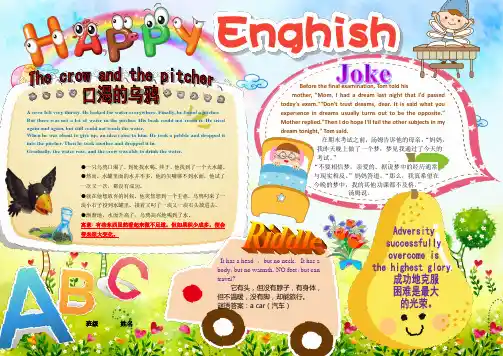
Before the final examination, Tom told hismother, "Mom, I had a dream last night that I'd passedtoday's exam.""Don't trust dreams, dear. It is said what youexperience in dreams usually turns out to be the opposite."Mother replied."Then I do hope I'll fail the other subjects in mydream tonight," Tom said.在期末考试之前,汤姆告诉他的母亲:“妈妈,我昨天晚上做了一个梦,梦见我通过了今天的考试。
”“不要相信梦,亲爱的。
据说梦中的经历通常与现实相反。
”妈妈答道。
“那么,我真希望在今晚的梦中,我的其他功课都不及格。
”汤姆说。
It has a head ,but no neck.It has abody,but no warmth.NO feet,but cantravel?它有头,但没有脖子,有身体,但不温暖,没有脚,却能旅行。
谜语答案:a car(汽车)A crow felt very thirsty. He looked for water everywhere. Finally, he found a pitcher.But there was not a lot of water in the pitcher. His beak could not reach it. He triedagain and again, but still could not touch the water.When he was about to give up, an idea came to him. He took a pebble and dropped itinto the pitcher. Then he took another and dropped it in.Gradually, the water rose, and the crow was able to drink the water.●一只乌鸦口渴了,到处找水喝。
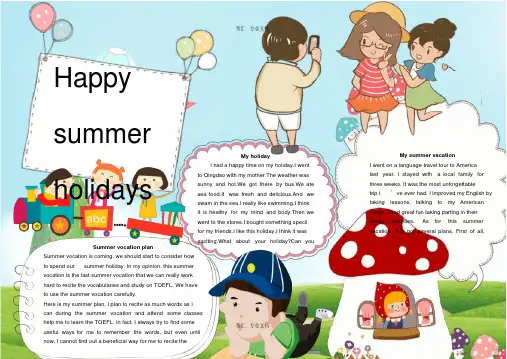
智汇专业文档智汇专业文档Happysummerholidays Summer vocation planSummer vocation is coming, we should start to consider how to spend our summer holiday. In my opinion, this summer vocation is the last summer vocation that we can really work hard to recite the vocabularies and study on TOEFL. We have to use the summer vocation carefully.Here is my summer plan, I plan to recite as much words as Ican during the summer vocation and attend some classes help me to learn the TOEFL. In fact, I always try to find some useful ways for me to remember the words, but even until now, I cannot find out a beneficial way for me to recite the My summer vacation I went on a language travel tour to America last year. I stayed with a local family for three weeks. It was the most unforgettable trip I ’ve ever had. I improved my English by taking lessons, talking to my American family. I had great fun taking parting in their family activities. As for this summer vacation, I've got several plans. First of all, My holidayI had a happy time on my holiday.I wentto Qingdao with my mother.The weather wassunny and hot.We got there by bus.We atesea food.It was fresh and delicious.And weswam in the sea.I really like swimming.I thinkit is healthy for my mind and body.Then wewent to the stores.I bought something specilfor my friends.I like this holiday,I think it wasexciting.What about your holiday?Can you。
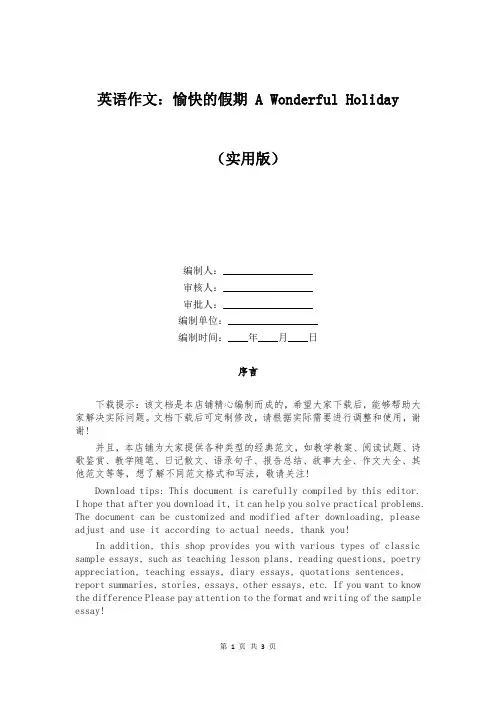
英语作文:愉快的假期 A Wonderful Holiday(实用版)编制人:__________________审核人:__________________审批人:__________________编制单位:__________________编制时间:____年____月____日序言下载提示:该文档是本店铺精心编制而成的,希望大家下载后,能够帮助大家解决实际问题。
文档下载后可定制修改,请根据实际需要进行调整和使用,谢谢!并且,本店铺为大家提供各种类型的经典范文,如教学教案、阅读试题、诗歌鉴赏、教学随笔、日记散文、语录句子、报告总结、故事大全、作文大全、其他范文等等,想了解不同范文格式和写法,敬请关注!Download tips: This document is carefully compiled by this editor.I hope that after you download it, it can help you solve practical problems. The document can be customized and modified after downloading, please adjust and use it according to actual needs, thank you!In addition, this shop provides you with various types of classic sample essays, such as teaching lesson plans, reading questions, poetry appreciation, teaching essays, diary essays, quotations sentences, report summaries, stories, essays, other essays, etc. If you want to know the difference Please pay attention to the format and writing of the sample essay!英语作文:愉快的假期 A Wonderful Holiday英语作文:愉快的假期 A Wonderful Holiday无论是身处学校还是步入社会,大家总免不了要接触或使用作文吧,作文一定要做到主题集中,围绕同一主题作深入阐述,切忌东拉西扯,主题涣散甚至无主题。
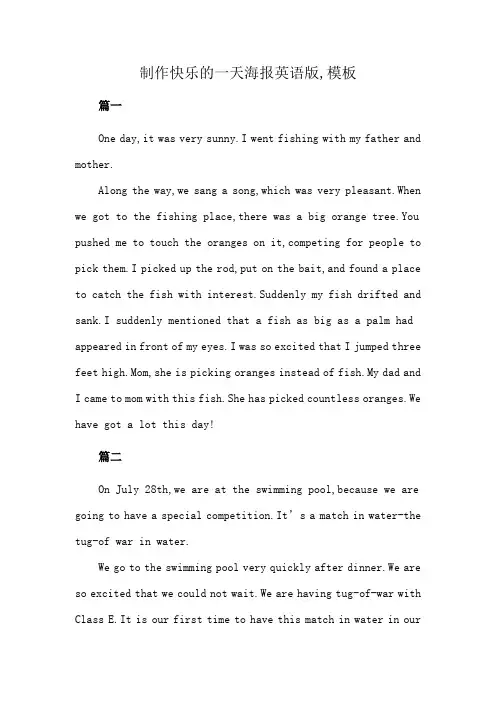
制作快乐的一天海报英语版,模板篇一One day,it was very sunny.I went fishing with my father and mother.Along the way,we sang a song,which was very pleasant.When we got to the fishing place,there was a big orange tree.You pushed me to touch the oranges on it,competing for people to pick them.I picked up the rod,put on the bait,and found a place to catch the fish with interest.Suddenly my fish drifted and sank.I suddenly mentioned that a fish as big as a palm had appeared in front of my eyes.I was so excited that I jumped three feet high.Mom,she is picking oranges instead of fish.My dad and I came to mom with this fish.She has picked countless oranges.We have got a lot this day!篇二On July 28th,we are at the swimming pool,because we are going to have a special competition.It’s a match in water-the tug-of war in water.We go to the swimming pool very quickly after dinner.We are so excited that we could not wait.We are having tug-of-war with Class E.It is our first time to have this match in water in ourlives.When we jump into the water,we all hold the rope tightly.After the judge’s whistle,we all try our best to pull the rope.But we feel very hard to stand in water.But we still tried our best.Because Class E has more students,we lose this game.But we are very happy.Today is really a happy day.篇三Today is May Day.My mother father and me went to park to have a piic,and then visited my grandma and grandpa.In the morning at nine o’clock,we went to park for piic,we took juice,cornflakes,apples,oranges,lollipops,bananas,ice creams,mangoes,and so on.I also took toys,such as doll,ball,balloon,skateboard and a kite.In the afternoon at two o’clock,we went to visit my grandma and grandpa.I helped grandpa to do some house work.My sister and me played skateboard and doll.At eight o’clock we went home,and played puter games for two hours and then went to bed.Today I’m very happy!。
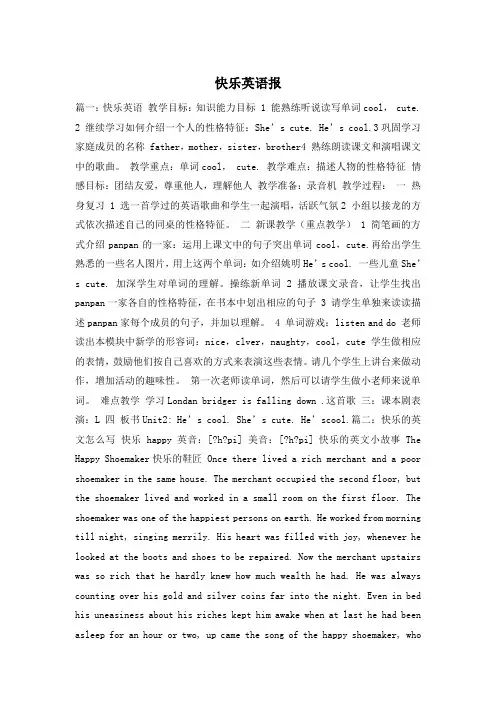
快乐英语报篇一:快乐英语教学目标:知识能力目标 1 能熟练听说读写单词cool, cute.2 继续学习如何介绍一个人的性格特征:She’s cute. He’s cool.3巩固学习家庭成员的名称 father,mother,sister,brother4 熟练朗读课文和演唱课文中的歌曲。
教学重点:单词cool, cute. 教学难点:描述人物的性格特征情感目标:团结友爱,尊重他人,理解他人教学准备:录音机教学过程:一热身复习 1 选一首学过的英语歌曲和学生一起演唱,活跃气氛2 小组以接龙的方式依次描述自己的同桌的性格特征。
二新课教学(重点教学) 1 简笔画的方式介绍panpan的一家:运用上课文中的句子突出单词cool,cute.再给出学生熟悉的一些名人图片,用上这两个单词:如介绍姚明He’s cool. 一些儿童She’s cute. 加深学生对单词的理解。
操练新单词 2 播放课文录音,让学生找出panpan一家各自的性格特征,在书本中划出相应的句子3 请学生单独来读读描述panpan家每个成员的句子,并加以理解。
4 单词游戏:listen and do 老师读出本模块中新学的形容词:nice,clver,naughty,cool,cute学生做相应的表情,鼓励他们按自己喜欢的方式来表演这些表情。
请几个学生上讲台来做动作,增加活动的趣味性。
第一次老师读单词,然后可以请学生做小老师来说单词。
难点教学学习Londan bridger is falling down .这首歌三:课本剧表演:L 四板书Unit2: He’s cool. She’s cute. He’scool.篇二:快乐的英文怎么写快乐 happy 英音:[?h?pi] 美音:[?h?pi] 快乐的英文小故事 The Happy Shoemaker快乐的鞋匠 Once there lived a rich merchant and a poor shoemaker in the same house. The merchant occupied the second floor, but the shoemaker lived and worked in a small room on the first floor. The shoemaker was one of the happiest persons on earth. He worked from morning till night, singing merrily. His heart was filled with joy, whenever he looked at the boots and shoes to be repaired. Now the merchant upstairs was so rich that he hardly knew how much wealth he had. He was always counting over his gold and silver coins far into the night. Even in bed his uneasiness about his riches kept him awake when at last he had been asleep for an hour or two, up came the song of the happy shoemaker, whowas an early riser. It continued all day and was a trouble to the merchant day by day the merchant grew more and more tired through want of sleep he asked a wise friend of his how he could put an end to the shoemaker s s ong. “Well, if I were you, I would give th e shoemaker a hundred pounds,” answered his friend. “You are rich enough to do that, I suppose. Ask for nothing in return. Simply give the money. ”The merchant readily followed the advice. When the shoemaker opened the bag that had been sent by the merchant, he was amazed to find shining coins. “I must hide this from the eyes of my neighbors. If they see it, they will think that I have stolen it,” he thought. “I will keep it away even from my wife.” So he hid the bag of money under the floor. From then on he avoided his neighbors as much as he could. His wife who had been the best companion to him, became troublesome now his mind was too much set on the money bag to attend to his work with diligence. He could not sing merrily now. Whenever he thought of the money bag, he became uneasy and unhappy. At length one day his wife said to him in tears, “dear husband, what makes you so sad and uneasy? All our neighbors say you have changed. I wish you were as good and gentle as before.” He was so sorry for her that he told her everything. “We were happy before the merchant gave us the money, ” said his wife, when she heard the story. “We have good health. We have plenty of work to do. What more do we need? Send the money back to the merchant, and the happy life that was once ours will return to us.” The shoemaker agreed and went to the merchant to return the bag of money. “Sir” he said, “let me return this to you. By giving this to me, you have spoiled my happy and easy life. So I want to have it back by returning your present.”Merry song was again heard all ov er the house. He was as happy as he had ever been. 曾经有一位富商和一个贫穷的鞋匠住在同一栋房子里。
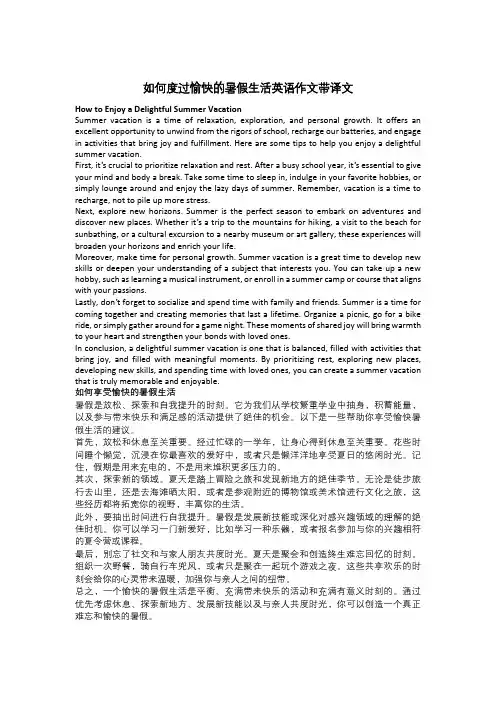
如何度过愉快的暑假生活英语作文带译文How to Enjoy a Delightful Summer VacationSummer vacation is a time of relaxation, exploration, and personal growth. It offers an excellent opportunity to unwind from the rigors of school, recharge our batteries, and engage in activities that bring joy and fulfillment. Here are some tips to help you enjoy a delightful summer vacation.First, it’s crucial to prioritize relaxation and rest. After a busy school year, it’s essential to give your mind and body a break. Take some time to sleep in, indulge in your favorite hobbies, or simply lounge around and enjoy the lazy days of summer. Remember, vacation is a time to recharge, not to pile up more stress.Next, explore new horizons. Summer is the perfect season to embark on adventures and discover new places. Whether it’s a trip to the mountains for hiking, a visit to the beach for sunbathing, or a cultural excursion to a nearby museum or art gallery, these experiences will broaden your horizons and enrich your life.Moreover, make time for personal growth. Summer vacation is a great time to develop new skills or deepen your understanding of a subject that interests you. You can take up a new hobby, such as learning a musical instrument, or enroll in a summer camp or course that aligns with your passions.Lastly, don’t forget to socialize and spend time with family and friends. Summer is a time for coming together and creating memories that last a lifetime. Organize a picnic, go for a bike ride, or simply gather around for a game night. These moments of shared joy will bring warmth to your heart and strengthen your bonds with loved ones.In conclusion, a delightful summer vacation is one that is balanced, filled with activities that bring joy, and filled with meaningful moments. By prioritizing rest, exploring new places, developing new skills, and spending time with loved ones, you can create a summer vacation that is truly memorable and enjoyable.如何享受愉快的暑假生活暑假是放松、探索和自我提升的时刻。
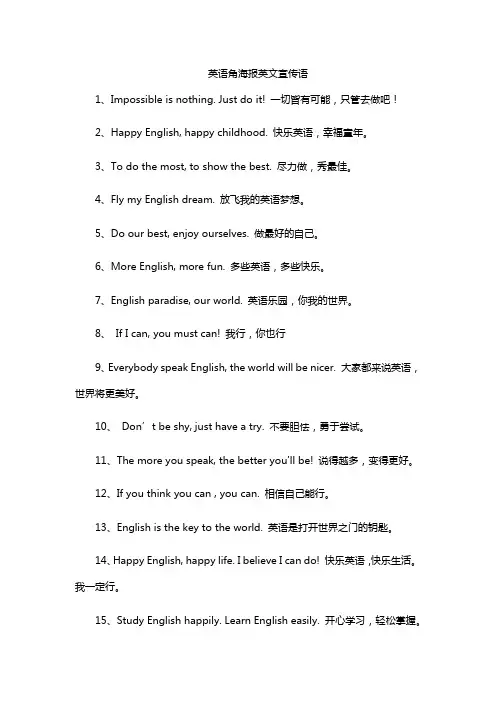
英语角海报英文宣传语1、Impossible is nothing. Just do it! 一切皆有可能,只管去做吧!2、Happy English, happy childhood. 快乐英语,幸福童年。
3、To do the most, to show the best. 尽力做,秀最佳。
4、Fly my English dream. 放飞我的英语梦想。
5、Do our best, enjoy ourselves. 做最好的自己。
6、More English, more fun. 多些英语,多些快乐。
7、English paradise, our world. 英语乐园,你我的世界。
8、If I can, you must can! 我行,你也行9、Everybody speak English, the world will be nicer. 大家都来说英语,世界将更美好。
10、Don’t be shy, just have a try. 不要胆怯,勇于尝试。
11、The more you speak, the better you'll be! 说得越多,变得更好。
12、If you think you can , you can. 相信自己能行。
13、English is the key to the world. 英语是打开世界之门的钥匙。
14、Happy English, happy life. I believe I can do! 快乐英语,快乐生活。
我一定行。
15、Study English happily. Learn English easily. 开心学习,轻松掌握。
16、Promise little, but do much. 少许愿,多行动。
17、Be the master of study. 做学习的主人。
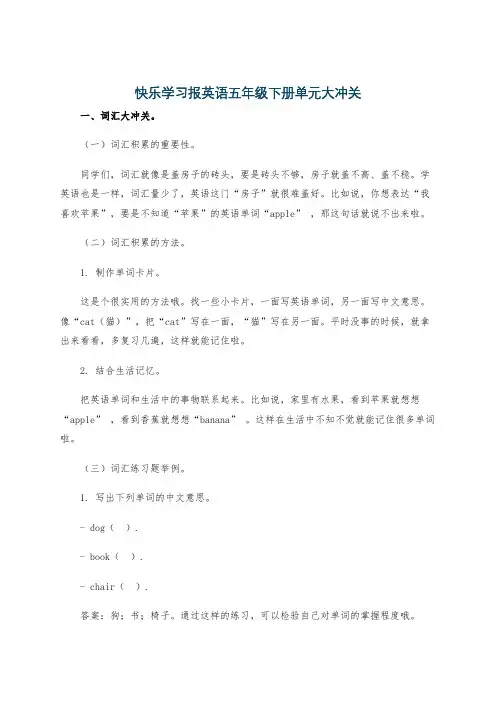
快乐学习报英语五年级下册单元大冲关一、词汇大冲关。
(一)词汇积累的重要性。
同学们,词汇就像是盖房子的砖头,要是砖头不够,房子就盖不高、盖不稳。
学英语也是一样,词汇量少了,英语这门“房子”就很难盖好。
比如说,你想表达“我喜欢苹果”,要是不知道“苹果”的英语单词“apple”,那这句话就说不出来啦。
(二)词汇积累的方法。
1. 制作单词卡片。
这是个很实用的方法哦。
找一些小卡片,一面写英语单词,另一面写中文意思。
像“cat(猫)”,把“cat”写在一面,“猫”写在另一面。
平时没事的时候,就拿出来看看,多复习几遍,这样就能记住啦。
2. 结合生活记忆。
把英语单词和生活中的事物联系起来。
比如说,家里有水果,看到苹果就想想“apple”,看到香蕉就想想“banana”。
这样在生活中不知不觉就能记住很多单词啦。
(三)词汇练习题举例。
1. 写出下列单词的中文意思。
- dog().- book().- chair().答案:狗;书;椅子。
通过这样的练习,可以检验自己对单词的掌握程度哦。
(一)语法学习的意义。
语法就像是交通规则,单词就是汽车。
要是没有交通规则,汽车就会乱开,容易出事故。
英语也是一样,没有语法,单词随便组合,别人就听不懂你在说什么啦。
“I like eat apples.”这句话就是错的,正确的应该是“I like eating apples.”,这就是语法的作用。
(二)常见语法点讲解。
1. 一般现在时。
一般现在时通常用来表示经常发生的动作或者存在的状态。
“I get up at 6o'clock every day.”(我每天六点起床。
)这里“get up”这个动作是经常发生的,所以用一般现在时。
当主语是第三人称单数(he/she/it等)时,动词要加“s”或者“es”,像“He likes reading books.”。
2. 现在进行时。
现在进行时表示正在进行的动作。
结构是“be + 动词的ing形式”。
快乐的星期六英语作文50字英语英文回答:Every Saturday is a day when we feel light and airy. It is a day when the week's stress and tension vanish, and we can relax and enjoy the simple pleasures of life. We can wake up late, have a leisurely breakfast, and read the newspaper in peace. We can spend time with our family and friends, go for a walk in the park, or just sit back and enjoy the sunshine. There are no deadlines to meet, no appointments to keep, and no worries to trouble our minds.Saturday is a day to recharge our batteries and prepare for the week ahead. It is a day to reflect on the past week and to set goals for the next. It is a day to dream and to plan, to laugh and to love.Saturday is a day to be happy.中文回答:快乐的星期六。
对于我们来说,每个星期六都是轻松自在的一天。
在这天里,一周的压力和紧张情绪烟消云散,我们可以放松身心,享受生活中简单的快乐。
我们可以睡个懒觉,悠闲地享用早餐,静静地读报纸。
我们可以与家人和朋友共度时光,在公园散步,或者只是坐下来享受阳光。
快乐英语报范文
快乐英语阅读
著名作家Francis Bacon曾说过:“ Reading makes a full man.”
可见,阅读对于每个人的成长都有着举足轻重的作用。在孩子学习英
语的过程中,阅读能够给孩子带来哪些提高呢?
1. 阅读是单词学习和记忆的最好场所。
通过阅读大量的英语文章,我们可以不断巩固所学单词还可以不
断扩大我们的词汇量。我们阅读英文是把理解的单位由词扩大到句子
甚至段乐的过程。在这个过程中我们见到的单词有了一定的环境,不
至于孤立的记忆。这样我们就会注意到单词在不同语境、不同结构中
的用法。这样我们对单词的理解就会更饱满更地道。
阅读的过程为我们提供了反复与单词见面的机会。从而加深单词
在我们大脑中的印象,很容易地把单词记下来。在阅读时,我们会遇
到大量的新词汇,这为扩充我们的词库提供了很好的机会。在特定的
环境中遇到生词,我们可以通过语境以及单词的搭配、结构来猜测单
词的意思;还可以通过查找词典获得对新词的理解。这比起孤立的、
死记硬背的去学习新词要好的多;这样新词留给我们的印象也会深刻
得多。
2. 阅读是句子学习的大舞台。
的阅读效果。这样会使我们的阅读过程充满探究,使阅读不再枯
燥乏味。
3. 阅读可以培养和增强学生的语感
学习英语,语感是非常重要的,因为它决定着你说出的语言是否纯
正地道。语感,即语言感受力。它是在长期的语言实践中形成的对语
言文字敏锐、丰富的感受领悟能力,是对特定环境中的话语不经过逻
辑推理,直接迅速整体地感知和把握。语感是在长期的语言实践中自
然而然形成的。阅读背诵是培养学生语感的最直接最基本的方法。读
的多了,日积月累,语感就慢慢地产生了。有了良好的语感,我们才
能克服英汉句子中词序的差异,才能讲纯正地道的英语。此外,良好
的语感对学生在各种中取得好成绩也大有帮助。作为一种隐形的英语
能力,语感能使学生跨越语法困难的障碍做出正确的判断。在解题的
时候,有些学生没有明确的根据,却能选出正确答案就是这个缘故。
4. 阅读能有效提高英语写作水平
英语写作作为一项重要的技能能反映一个人的综合英语学习水平。
在英语学习中,写作既是一个重点又是一个难点。 __用英语写出好
文章呢?除了要打下牢固的语言基础,即一定词汇、语法基础外,大量
的阅读也是必不可少的。关于阅读和写作的关系,中文有很多俗语:
“读书破万卷,下笔如有神。”,“熟读唐诗三百首,不会做诗也会吟。”
等等,英文同样如此,只有读得多了,见得广了,才能写出精彩的东
西。通过大量阅读,广泛地接触语言材料,一方面,我们可以积累大
量优美的词句、英语格言、警句、固定表达、习惯用语、修辞常识等,
将其吸收内化为自己的东西,然后在我们的文章中编码输出;另一方
面,在揣摩作者意图,把握文章整体框架结构的基础上,我们还可以
有意识地模仿作者谋篇布局、文章衔接、遣词造句等建构篇章的技能。
此外,大量的阅读有助于培养英
语思维,只有用英语来思考我们的文章中才会避免汉语式的英语
出现,才能创造出优美地道的英文作品。
5. 阅读可以使学生了解西方风俗文化,开阔眼界
语言与文化之间存在着密不可分的关系。语言是文化的结晶和载
体,文化又影响着语言。美国语言学家Lado曾指出“如果没有很好
的掌握一种文化的背景,,就不能很好的学习这门语言。”由此可见,
要学好英语还要了解英语国家的风俗文化。而阅读则是了解西方风俗
文化的最佳手段。通过阅读可以了解到不同国家的历史地理、政治经
济、文学哲学、宗教、科技等,从而不仅促进了英语语言的学习,还
使我们增长了知识,增加了阅历,丰富了生活,有助于我们开拓视野,
培养积极乐观的生活态度。
可见,阅读的大量进行有助于英语各种技能的提高。因此,在英
语教学中,应启发学生认识阅读在英语学习中的重要性,鼓励学生不
断提高阅读技能,通过大量阅读学好英语。
快乐英语 快乐课堂
王瑞双
背景:
我在上小学一年级英语口语课Unit3 中的Let’s sing时,刚开
始学习了一会儿,我就发现有一部分学生表现出烦躁、注意力不集中
的现象,还有些学生甚至在偷着与他人搞小动作,直接影响了我的教
学活动。
经过:
看到此现象,我并没有气馁,也没有生气。我迎合着他们的愿望,
及时作出策略调整:吸引他们的注意力,把小动作变成我的规范动作,
跟我学唱、表演。我让全体学生起立,像我一样站好,跟我开始学做。
乐曲开始,伴随着音调的高低、节奏的轻缓以及我的吟唱,学生们也
跟随着进入状态:高音时用右手,低音时用左手,脚也踩着节拍;只
有独立单词时,手是上下对应单词摆动,句子时,手是平滑。我示范
了一遍,学生们看着好玩又有趣,也跟我学起。我注意观察着学生们
的表现:有些学生认认真真地跟我做,跟着唱;有些学生不好意思,
象征性的做做;而还有一些学生则夸大动作幅度,与旁边的学生发生
肢体碰触,还带着挑衅的表情......这些被我一一看到眼里。我只对
个别存在安全隐患的学生点名提醒,其它则忽略不计,目的是给那些
学生提供自我纠正的时间,并让胆小的学生慢慢地对自己有信心。但
我记下了这些学生。反复多遍熟悉之后,我看有些学生的注意力要下
降了。这时我提出比一比,看谁表演好,谁最棒。学生们的注意力又
都聚到我这里来了,我问他们谁来试一试,请举手,结果他们都
面面相觑,看到此景,我直接点了名。我叫了五位刚才表现不好的学
生,还叫了两位表现好的学生。我让他们面向同学,而我站在他们后
面,音乐响起,我和学生们随着音乐连唱在演。结果表演的7位学生
动作不到位,不成功,不能回座。第二遍表现好的两位同学跟唱了,
动作到位,成功回到座位,再补充两位,然后第三遍......直到动作
到位才回座,在前面表演的同学因为之前没好好学所以不全会,多次
之后他们学聪明了,直接转过身跟我学。而没到前面来表演的学生也
有动力,想到前面表现,让老师表扬,因此很努力地学习。当时课堂
上的氛围既热闹,又有序。学生们学习的热情高涨,我则适当降低自
己的音量甚至于只张口型演唱。渐渐地学生们演唱的声音超过了我,
最后达到完全跟唱下来……正在我们沉浸在课堂的快乐中时,下课铃
响了,学生们与我依依不舍地再见,我非常快乐地与他们道别,因为
我非常满意我的这节课,达到了我的教学目标——快乐学会歌曲。 结
果:
一堂课结束,教学效果令人满意。大部分学生能跟着音乐演唱完
整的英文歌曲,下课了还意犹未尽,个个脸上洋溢着快乐的笑容,欢
快地与我再见,学生高兴,教师快乐,这就是我在践行素质下的英语
课堂。
分析:
我深知学生的特点:刚入学不久,很多行为习惯没有养成;而且
少年儿童的天性是好玩、好动,注意力持续时间不长,自我约束
能力差等。针对他们的特点我适时的加以调控、改变教学策略:
学生好玩好动,我让他们玩让他们动;注意力不能持续长久,我在他
们快坚持不住时,改变教学方法,重新又引起他们的注意力;对于自
我约束能力差的学生我直接让他们成为我的model,到前面来展示。
表扬表现好的学生,儿童们的好胜心都很强,为了得到老师的肯定,
他们都努力表现,因此又为他们的学习注入了动力,达到了理想的教
学效果。
内容仅供参考